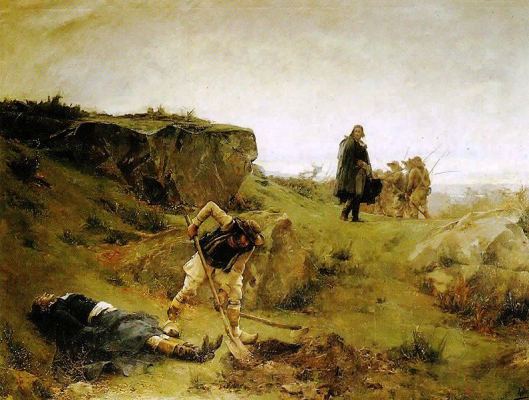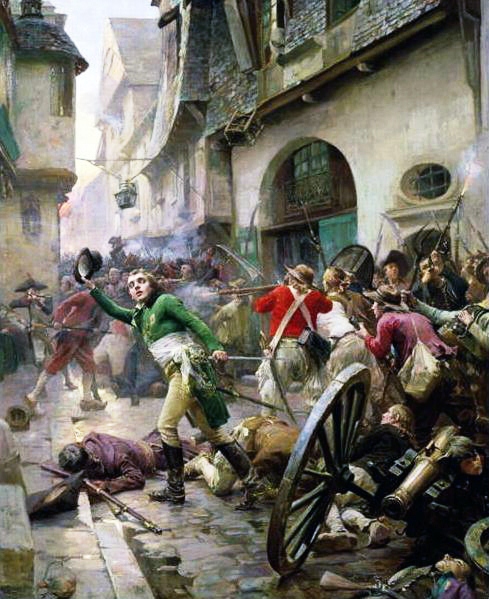Tags
Chouannerie, Honoré de Balzac, Les Chouans, Maximilien de Robespierre, Ninety-Three, Ninth Thermidor, The Reign of Terror, Thomas-Alexandre Dumas, Victor Hugo, War in the Vendée
 (Photo credit: Wikipedia)
(Photo credit: Wikipedia)
The Reign of Terror
The French Revolution is an event one can understand. Its aims were noble: liberté, égalité, fraternité. But the Reign of Terror (5 September 1793 – 28 July 1794) seems incomprehensible. It was a period of unparalleled savagery that ended on 27 July 1794. The following day, 28 July 1794, Maximilien Robespierre and Louis Antoine Léon de Saint-Just (25 August 1767 – 28 July 1794) were guillotined. Saint-Just was the main instigator in the excesses of the Terror, or its “Angel of Death.”
Contradictions
Yet, it is during this horrible period of the French Revolution that slavery was abolished. (See Maximilien de Robespierre, Wikipedia)
On the 4th of February 1794 under the leadership of Maximilien Robespierre, the French Convention voted for the abolition of slavery.
In his Black Count, Tom Reiss[i] writes that
“[t]he story of General Dumas brilliantly illuminates the first true age of emancipation: a single decade during which the French Revolution not only sought to end slavery and discrimination based on skin color but also broke down the ghetto walls and offered Jews full civil and political rights, ending a near-universal discrimination that had persisted since ancient times. (Reiss, p. 11)”
But, in chapter 13 of The Black Count, entitled “The Bottom of the Revolution” (pp. 175-187), Reiss also tells about the “Terror.”

The Death of Henri de La Rochejacquelein (aged 26), by Alexandre Bloch (Photo credit: Wikipedia)
The War in the Vendée: la Chouannerie
General Dumas was called upon to suppress the royalist uprisings in the west of France: the Vendée. (See War in the Vendée, Wikipedia). According to Tom Reiss, Thomas-Alexandre Dumas, now called Alex Dumas, “risked his career to oppose the bloodshed he saw all around him.” Later, a pro-royalist wrote that Dumas was one of those rare generals who were “always ready bravely to sell their lives on the battleground, but resolved to break their swords than consent to the role of executioners” (Reiss, pp. 11-12).
These royalist uprisings are called “chouanneries,” after Jean Chouan (Jean Cottereau’s nom de guerre). They started during the Revolution, but continued beyond 1799. Thomas-Alexandre Dumas was sent to the Vendée in 1794 but he proved a “generous republican.” (Reiss, p. 12) and was called “Mr Humanity” (Reiss, pp. 146-159).
The chouanneries killed nearly 600,000 Royalists.
Honoré de Balzac & Victor Hugo
French novelist Honoré de Balzac (20 May 1799 – 18 August 1850) wrote Les Chouans, in 1829, one of two novels that brought him “to the brink of success,”[ii] and Victor Hugo (26 February 1802 – 22 May 1885) wrote Ninety-Three (Quatrevingt-treize) in 1874.[iii] These are extraordinary books.

Henri de La Rochejacquelein at the Battle of Cholet in 1793, by Paul-Émile Boutigny, (19th century), Musée d’art et d’histoire de Cholet, Cholet, France. (Photo credit: Wikipedia)
“The Bottom of the Revolution”
Robespierre abolished slavery, but, ironically, once he stood on the top rung of the ladder, he gave himself permission to kill those he had the power to kill. He in fact acted like a slave owner. However, when it hit bottom, the Revolution also ended. It hit bottom on 9 Thermidor Year II (27 July 1794). It had exhausted itself and there was no one left to kill. During the “Reign of Terror,” 16,594 were executed by guillotine, and 25,000, in summary executions all over France.
—ooo—
In closing, I should tell you that the 1833 translation of The Slave-King (simply click on the title), from Victor Hugo’s Bug-Jargal, is online. A more recent translation is available, but it is not online.
“The novel follows a friendship between the enslaved African prince of the title and a French military officer named Leopold d’Auverney during the tumultuous early years of the Haitian Revolution.” (See Bug-Jargal, Wikipedia.)
Moreover, Toussaint Louverture’s story was told by C. L. R. James in his 1989 The Black Jacobins: Toussaint L’Ouverture and the San Domingo Revolution.
Sources:
- Balzac: Les Chouans is a Project Gutenberg publication [EBook #1921] EN
- Hugo: Quatre-vingt-treize is a pdf publication FR (on the French Revolution, the Terror)
- Hugo: Ninety-three is an online publication EN
- Hugo: Quatrevingt-treize is an audio publication FR
- Hugo: The Slave-King is an online publication EN
_________________________
[i] Tom Reiss, The Black Count: glory, revolution, betrayal, and the real Count of Monte Cristo (New York: Crown Publishers, 2012).
[ii] “Honoré de Balzac.” Encyclopædia Britannica. Encyclopædia Britannica Online. Encyclopædia Britannica Inc., 2014. Web. 01 Feb. 2014. <http://www.britannica.com/EBchecked/topic/51100/Honore-de-Balzac>.
[iii] “Victor Hugo.” Encyclopædia Britannica. Encyclopædia Britannica Online. Encyclopædia Britannica Inc., 2014. Web. 01 Feb. 2014. <http://www.britannica.com/EBchecked/topic/274974/Victor-Hugo>.
La Marseillaise (The National Anthem of France) Plácido Domingo Daniel Barenboim (conductor) The Chicago Symphony Orchestra (Rouget de l’Isle, Pleyel, Hector Berlioz)
The Defence of Rochefort-en-Terre, by Alexandre Bloch, 1885 (Photo credit: Wikipedia)


Thank you, Micheline. Both interesting and ironic.
LikeLike
I’m rather glad France had abandoned New France. We may have been a mere “few acres of snow,” (Voltaire) but we were not killing one another. As well, Britain had made us fully-fledged British citizens, so we had a Parliament. And we’re still here speaking French.
Best,
Micheline
LikeLike
Real interesting! I guess to term such turn-about decisions as fickle will be to simply things. But I don’t know any other term to use in describing these ironies of the human mind. The thing is that these ironies changed human history, for good, or bad? 🙂
Great post as always, Micheline.
LikeLike
The French Revolution is filled with ironies. It did change history, but it was a blood bath. The “philosophes” of the Enlightenment would have been shocked.
Best,
Micheline
LikeLike
Hi, i have reading out and i will definitely bookmarrk your site, just wanted to say i liked this article.
LikeLike
I’m very late reading your comment, but wish to thank you for writing and for liking “Ninth Thermidor.” Terrorism is not new.
Cheers,
Micheline
LikeLike